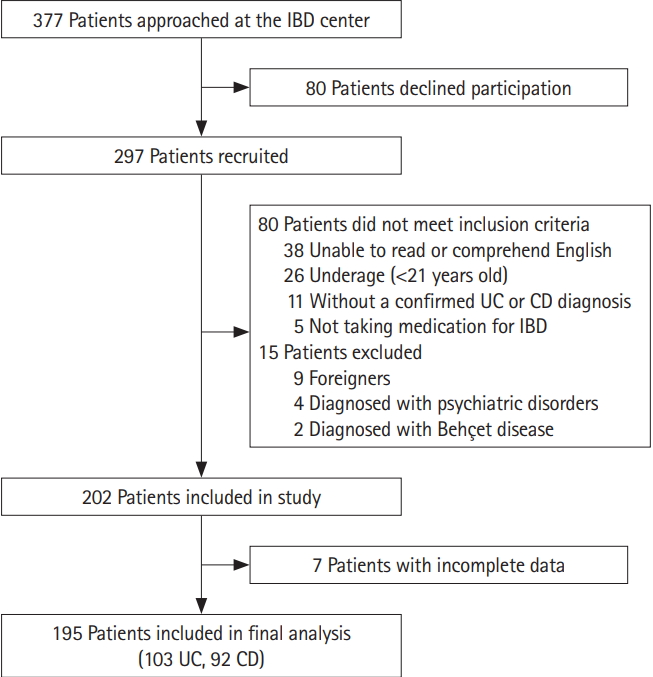 |
 |
- Search
| Intest Res > Volume 17(1); 2019 > Article |
|
Abstract
Background/Aims
Methods
Results
Conclusions
NOTES
FINANCIAL SUPPORT
The authors received no financial support for the research, authorship, and/or publication of this article.
AUTHOR CONTRIBUTION
Conceptualization: Ong WC and Cheen HH. Methodology: Ong WC, Chenn HH, Wee HL, and Lim TG. Formal analysis: Ho YM, Hu W, Lee YY, Gao C, Tan YZ, Cheen HH, and Ong WC. Funding acquisition: Nil. Project administration: Wee HL and Lim TG. Visualization: Ho YM, Hu W, Lee YY, Gao C, Tan YZ, Cheen HH, and Ong WC. Writing-original draft: Ho YM, Hu W, Lee YY, Gao C, Tan YZ, Cheen HH, and Ong WC.
ACKNOWLEDGEMENTS
TableĀ 1.
| Characteristics | All patients (n=195) | UC (n=103) | CD (n=92) | P-value |
|---|---|---|---|---|
| Socio-demographics | ||||
| āAge (yr) | 47.1Ā±15.3 | 51.4Ā±13.6 | 42.3Ā±15.8 | <0.001 |
| āSex | 0.200 | |||
| āāMale | 131 (67.2) | 65 (63.1) | 66 (71.7) | |
| āāFemale | 64 (32.8) | 38 (36.9) | 26 (28.3) | |
| āRace | 0.992 | |||
| āāChinese | 123 (63.1) | 65 (63.1) | 58 (63.0) | |
| āāMalay | 16 (8.2) | 8 (7.8) | 8 (8.7) | |
| āāIndian | 50 (25.6) | 27 (26.2) | 23 (25.0) | |
| āāEurasian/others | 6 (3.1) | 3 (2.9) | 3 (3.3) | |
| āEducational level | 0.146 | |||
| āāNon-tertiary | 74 (37.9) | 44 (42.7) | 30 (32.6) | |
| āāTertiary & above | 121 (62.1) | 59 (57.3) | 62 (67.4) | |
| āEmployment status | 0.880 | |||
| āāNon-employed | 52 (26.7) | 27 (26.2) | 25 (27.2) | |
| āāEmployed | 143 (73.3) | 76 (73.8) | 67 (72.8) | |
| āMonthly income status | 0.658 | |||
| āāLow (<$3,000) | 105 (53.8) | 57 (55.3) | 48 (52.2) | |
| āāHigh (ā„$3,000) | 90 (46.2) | 46 (44.7) | 44 (47.8) | |
| āHousing type | 0.206 | |||
| āāPublic | 158 (81.0) | 80 (77.7) | 78 (84.8) | |
| āāPrivate | 37 (19.0) | 23 (22.3) | 14 (15.2) | |
| āMarital status | 0.016 | |||
| āāSingle | 52 (26.7) | 18 (17.5) | 34 (36.9) | |
| āāMarried | 136 (69.7) | 80 (77.6) | 56 (60.9) | |
| āāWidowed | 5 (2.6) | 4 (3.9) | 1 (1.1) | |
| āāDivorced | 2 (1.0) | 1 (1.0) | 1 (1.1) | |
| āSmoking status | 0.314 | |||
| āāNon-smoker | 148 (75.9) | 81 (78.7) | 67 (72.8) | |
| āāSmoker | 17 (8.7) | 6 (5.8) | 11 (12.0) | |
| āāFormer-smoker | 30 (15.4) | 16 (15.5) | 14 (15.2) | |
| āCCI | 0.26Ā±0.69 | 0.32Ā±0.66 | 0.18Ā±0.71 | 0.007 |
| Clinical characteristics | ||||
| āDisease duration (yr) | 11.2Ā±9.0 | 12.6Ā±9.6 | 9.6Ā±8.0 | 0.018 |
| āDisease activity | 0.012 | |||
| āāRemission | 144 (73.8) | 67 (65.1) | 77 (83.7) | |
| āāMild | 47 (24.1) | 33 (32.0) | 14 (15.2) | |
| āāModerate | 4 (2.1) | 3 (2.9) | 1 (1.1) | |
| āāSevere | 0 | 0 | 0 | |
| āCD: disease location | ||||
| āāIleitis | - | - | 29 (31.5) | |
| āāIleocolitis | - | - | 39 (42.4) | |
| āāColitis | - | - | 22 (23.9) | |
| āāIsolated upper GIT | - | - | 2 (2.2) | |
| āCD: disease behavior | - | |||
| āāNonstricturing, nonpenetrating | - | - | 52 (56.5) | |
| āāStricturing | - | - | 15 (16.3) | |
| āāFistulising | - | - | 12 (13.1) | |
| āāStricturing & fistulising | - | - | 13 (14.1) | |
| āCD: perianal disease | - | - | 14 (15.2) | - |
| āUC: type | - | |||
| āāProctitis | - | 16 (15.5) | - | |
| āāProctosigmoiditis | - | 22 (21.4) | - | |
| āāLeft-sided colitis | - | 27 (26.2) | - | |
| āāPancolitis | - | 34 (33.0) | - | |
| āāPouchitis | - | 4 (3.9) | - | |
| āTreatment modalities | ||||
| āā5-Aminosalicylates | 148 (75.9) | 100 (97.1) | 48 (52.2) | <0.001 |
| āāImmunomodulators | 92 (47.2) | 24 (23.3) | 68 (73.9) | <0.001 |
| āāCorticosteroids | 31 (15.9) | 15 (14.6) | 16 (17.4) | 0.590 |
| āāBiologics | 44 (22.6) | 7 (6.8) | 37 (40.2) | <0.001 |
| āMedication adherence | 0.181 | |||
| āāAdherent (MARS ā„20) | 166 (85.1) | 91 (88.3) | 75 (81.5) | |
| āāNon-adherent (MARS <20) | 29 (14.9) | 12 (11.7) | 17 (18.5) | |
| āExtraintestinal manifestations | 0.059 | |||
| āāYes | 14 (7.2) | 4 (3.9) | 10 (10.9) | |
| āāNo | 181 (92.8) | 99 (96.1) | 82 (89.1) | |
| āCRP (mg/L)a | 0.852 | |||
| āāā¤9.1 | 160 (82.1) | 83 (80.6) | 77 (83.7) | |
| āā>9.1 | 26 (13.3) | 14 (13.6) | 12 (13.0) | |
| āFC (Ī¼g/g)b | 0.036 | |||
| āāā¤200 | 67 (34.4) | 39 (37.9) | 28 (30.5) | |
| āā>200 | 74 (37.9) | 30 (29.1) | 44 (47.8) | |
| āHospitalizations over 1 yr | 0.55Ā±1.39 | 0.37Ā±1.35 | 0.75Ā±1.41 | 0.001 |
| āSurgeries over 1 yr | 0.01Ā±0.10 | 0.00Ā±0.00 | 0.02Ā±0.15 | 0.134 |
TableĀ 2.
TableĀ 3.
Statistical significance: aP<0.05, bP<0.01, cP<0.001.
SIBDQ, short IBD questionnaire; SF-36 PCS, physical component summary of Short Form-36; SF-36 MCS, mental component summary of Short Form-36; EQ-5D-3L, EuroQol 5-dimensions 3-levels; VAS, visual analogue scale of EuroQol-5D; MARS, Medication Adherence Report Scale.
TableĀ 4.
REFERENCES
- TOOLS









